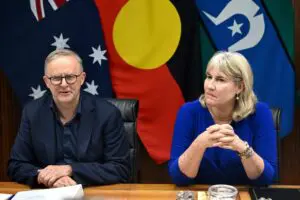The NSW government could consider using new powers to prohibit renewable energy projects from connecting to the grid in circumstances where there is strong community opposition to the project, in a message to project developers that building and maintaining strong social licence will be critical to the state’s renewable energy zones.
Speaking to the Large-scale Solar Forum hosted by the Clean Energy Council on Thursday, the NSW government’s director for energy infrastructure and zones, Chloe Hicks, said the development of social licence between renewable energy developers and the communities where projects will be built would be key to the successful development of the renewable energy zones that are planned across New South Wales.
“Social licence is absolutely central to the delivery of [Renewable Energy Zones] and the [electricity infrastructure] roadmap and its enabling legislation,” Hicks told the forum.
“And you will see that in the legislation that five of the objects of the Act specifically go to this point, and they are to foster local community support for energy investment, support economic development and manufacturing, create employment, including for First Nations people invest in education and training and promote local industry, manufacturing, and jobs.”
Hicks said that there was already evidence of early concerns being raised about engagement the state’s first Renewable Energy Zone, planned for the central-west region of the state and stressed the importance of prospective project developers identifying and communicating the opportunities projects would bring to local communities, including job creation and skilled training.
“We’re already starting to hear some concerns in the Central West Orana region, about some of the ways landholders are being approached and some activities as well, where concerns are increasing around things like prime agricultural land, and it’s already starting to undermine the social licence within that region. So I can’t stress enough how important these points are and that they will just be fundamental to all aspects of the REZ program,” Hicks said.
Under new legislation recently passed by the NSW parliament, the NSW government has the power to prohibit projects from connecting to the grid within a renewable energy zone where there is “significant opposition from the community in the local area” in an effort to maintain goodwill with the local community.
“The strong preference is that it never needs to be used because, hopefully, we see projects coming forward that have the social license and have done really good engagement and benefit sharing,” Hicks said.
“It’s really about stopping that idea where you’re only as strong as your weakest link. And if there’s one project that seem to undermine all of the investments of everyone else within the renewable energy zone, that’s what we’re talking about. So hopefully, we never need to actually use that.”
Andrew Bray, the national director of the RE-Alliance, which has long served as renewable energy advocate and intermediator between projects and local communities, told the forum that early engagement by project developers with the local community was critical and warned that once community confidence in a project was lost, it was virtually impossible to gain it back.
“Once you piss people off in the country, they don’t forgive you,” Bray said. “The successful [projects] have kind of worked on that basis, and obviously, the lesson here is don’t stuff up in the first place.”
Bray alluded to the example of the Jupiter wind farm, which had been proposed to be constructed in the NSW southern tablelands but was ultimately abandoned by the project’s developers as it had been unable to resolve the concerns raised by local community members, including opposition from the RE-Alliance (then known as the Australian Wind Alliance).
“We some years ago objected to a wind project in the New South Wales planning system because we saw that their community engagement was not up to scratch. It’s not something we’ve ever done since, and we’ve only done it once. But it’s just such an important part of the social licence to the whole industry that it’s really important you get it right the first time,” Bray said.
Bray added that the successful development of the early Renewable Energy Zones would be key to the success of future zones, particularly when it came to winning community support.
“It’s hard enough to win social licence for a single project. But the great risk of REZs is, if locals start pushing back and coalescing their grievances, is if they coalesce into a basic rejection of the REZ premise. That’s where we’ll start to see some real issues come up,” Bray said.
“The key question I think we need to be asking is, what can we do to make sure that regional communities want us to be there. So they don’t just sort of tolerate their presence, but they actually look at the first REZ that rolls out, they look at the second one, and think, ‘what can we do to get one of those in this neck of the woods?’”










